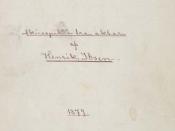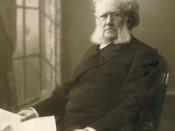It is fascinating how a writer's personal beliefs, upbringing, and era can dramatically change a characters persona. One such character is Nora Helmer from a play called "A Doll's House". "A Doll's house" was originally written in 1879 by Henrik Ibsen. Henrik Ibsen was born in 1828 in Skien, Norway. Ibsen portrays Nora as a person with very low self esteem, untrustworthy, and self absorbed. During Ibsen's era women where subservient and listen to what they are told by the dominant man in their life. Ibsen's own views about women come through in this character. Even though Ibsen attempts to address women's rights, he fails women by portraying Nora as a selfish woman who ran out on her family to fulfill her own needs.
The play "A Doll's House" was written ahead of its time, addressing issue related to women's rights. Although Ibsen does attempt to tackle women's rights as a matter of importance, he fails to do so.
By portraying Nora as an unintelligent, selfish person, Ibsen directly contradicts his own belief that women have rights. Throughout the 1800 and early 1900 hundreds women rights where completely ignored. "A Doll's House" was written during the movement of Naturalism, which commonly reflected society. Ibsen acknowledges the fact that in the 19th century the role of a woman was to stay at home, raise the children and attend to her husband, again showing his own ideals and nature. Nora Helmer in "A Doll House" is portrayed as a victim, instead of a strong independent woman. Nora is oppressed by a variety of totalitarian social conventions. Ibsen depicts the role of women as subordinate in order to emphasize their role in society for that era. Nora is oppressed by the manipulation from Torvald, and Krogstad.
Nora and Torvald's relationship on the...


